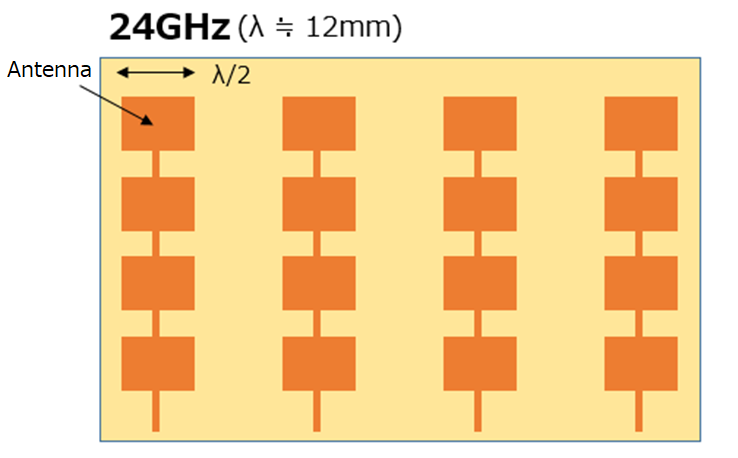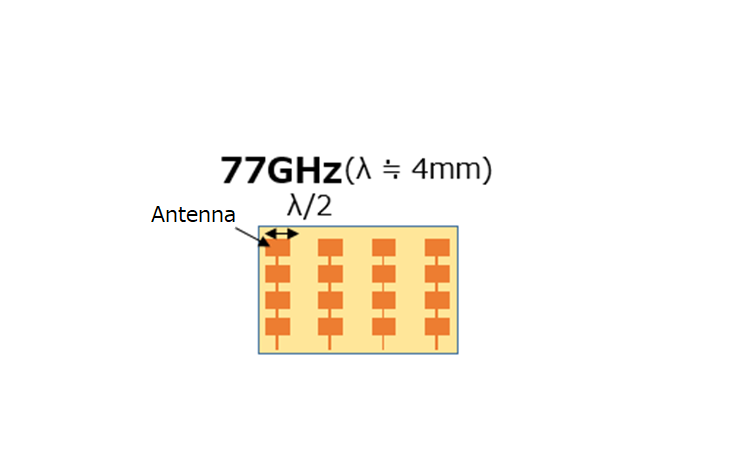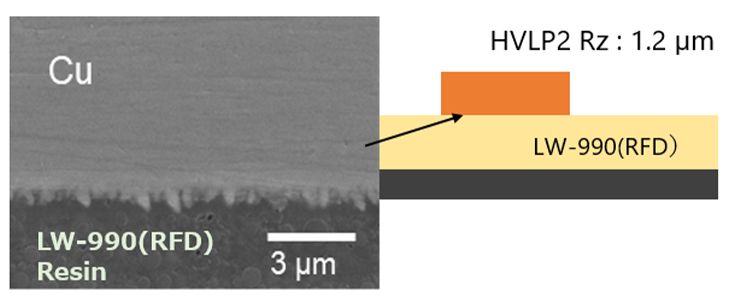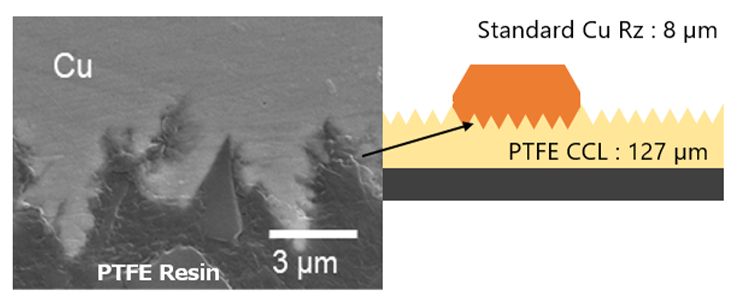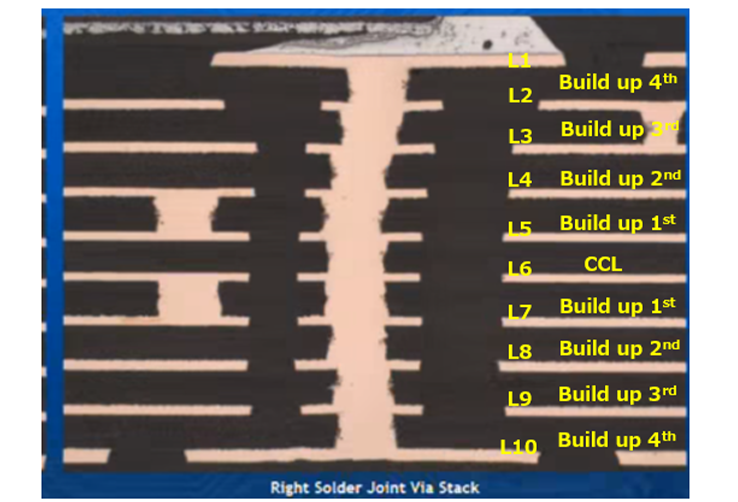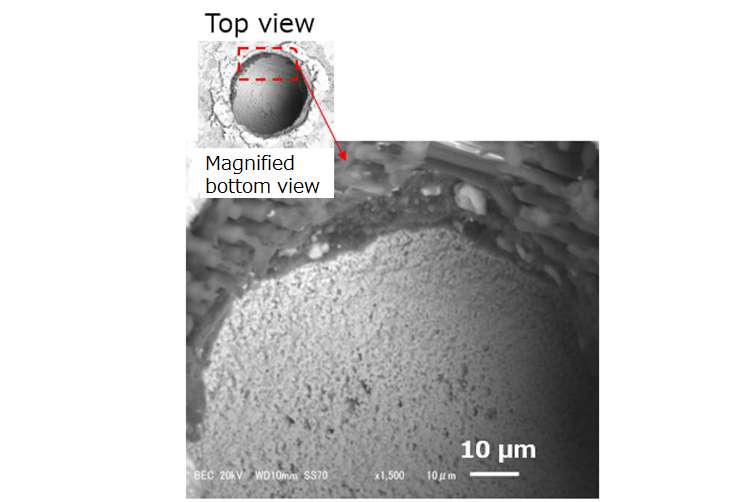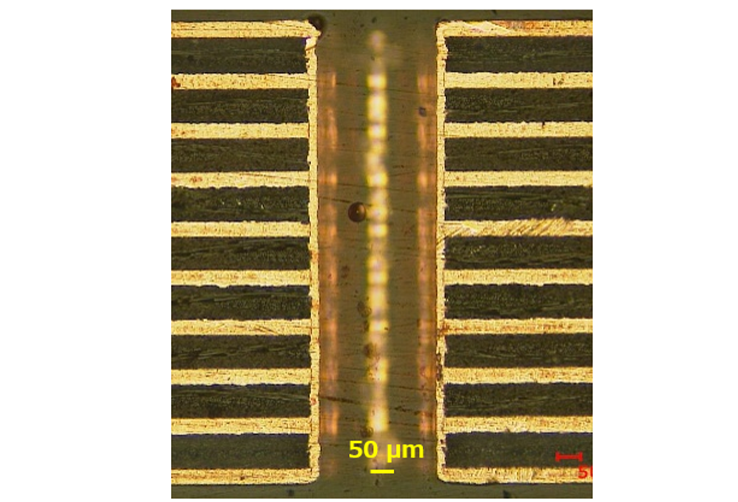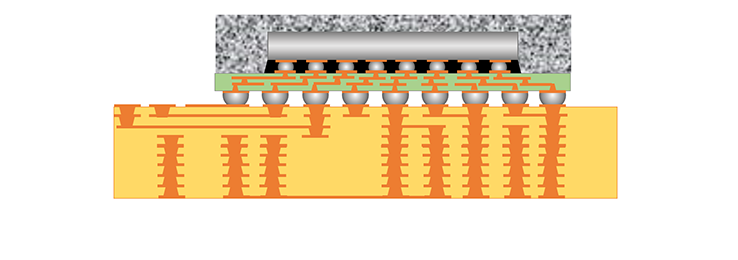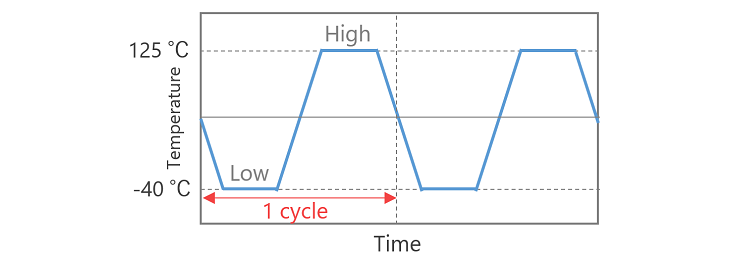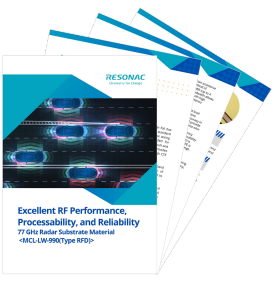With Level 4 autonomous vehicles (fully autonomous driving without human assistance or intervention) coming into practical use, millimeter-wave radars as a method of sensing are being developed in the 77 GHz band (the 76 GHz and 79 GHz bands collectively referred to here as the 77 GHz band), where a wider bandwidth (up to 4 GHz) is authorized, replacing the conventional 24 GHz band. The wider bandwidth allows these radars to realize high range resolution and measurement accuracy, with high frequencies and short wavelengths facilitating high speed resolution and antenna miniaturization. The use of 77 GHz-band millimeter-wave radar substrates requires high board level reliability (BLR) and high-frequency dielectric properties necessary for automotive materials. These substrates must also meet stricter requirements for wiring accuracy in response to impedance matching in a wide bandwidth and miniaturization and provide superior processability that includes anylayer technology stackups for super dense wire routing.
Polytetrafluoroethylene (PTFE), conventionally known as a low dielectric material, has weak adhesion. So, substrates using PTFE provide poor wiring accuracy due to its incompatibility with low-roughness copper foil as well as inferior processability of PCB with higher processing costs. On the other hand, polyphenylene ether (PPE) is known as a highly adhesive thermosetting resin, but its BLR for substrates using PPE is low. Developing materials with both high adhesion and reliability has been a challenge.
Resonac recommends its 〈MCL-LW-990(Type RFD)〉 (hereafter 〈LW-990(RFD)〉) as a substrate material offering excellent reliability for substrates using highly adhesive thermosetting resins. Our 〈LW-990(RFD)〉 achieves superiority in RF performance, wiring accuracy, processability, and reliability, thereby meeting the challenges of high accuracy, miniaturization, and high reliability required of 77 GHz-band millimeter-wave radar substrate materials.
Frequency band available for automotive millimeter-wave radars
(shifting from the 24 GHz to 77 GHz band: the EU’s case)
Comparison of antenna size between the 24 GHz and 77 GHz bands
Innovative Solution
Low CTE, low elastic modulus thermosetting resin substrate material with modified PI polymer and soft segments optimally compounded
The low dielectric material PTFE cannot be used with low-roughness copper foil due to its poor adhesion with the absence of functional groups. Patterning standard copper foil with high roughness requires excessive etching, resulting in poor wiring formation accuracy and lower yields. In addition, adhesives are needed for multilayering, while processing such as buildup and via formation is both difficult and expensive. PPE commonly used as a thermosetting resin substrate material provides poor BLR for antenna substrates and semiconductor packages due to its high CTE and high elastic modulus.
To overcome these challenges, Resonac recommends its own 77 GHz-band millimeter-wave radar substrate material 〈LW-990(RFD)〉, a product made of thermosetting resin with modified PI and soft segments optimally compounded to provide superior BLR due to its low CTE and low elastic modulus.
〈LW-990(RFD)〉 can be applied to low-roughness copper foil as it contains functional groups with high adhesion and allows rectangular-shaped traces to be fabricated with high accuracy and yields in PCB manufacturing. Our 〈LW-990(RFD)〉 facilitates multilayer formation, provides excellent processability for antenna substrates, and enables small antenna substrates with complex wire routing to be fabricated at lower cost. Our product also features high-frequency properties that can be used in the 77 GHz band.
Product Features
Using low-roughness copper foil to achieve high wiring formation accuracy
The 77 GHz-band millimeter-wave radar entails stricter requirements for wiring accuracy as it is required to respond to impedance matching and miniaturization in a wide bandwidth. Low-roughness copper foil cannot be used for substrates using weak-adhesion PTFE. Instead, standard copper foil with high surface roughness should be applied, but patterning this foil requires excessive etching, resulting in the formation of trapezoidal-shaped wires and lower wiring formation accuracy and yields.
Resonac’s <LW-990(RFD)>, on the other hand, features high adhesion and compatibility with low-roughness copper foil and offers superior wiring formation accuracy with accurate rectangle wires.
Comparison of rectangular-shaped wires using the subtractive method
- ※ The data shown are representative values that represent examples of the results of measurements, calculations, etc., and are not guaranteed values.
Easy lamination of multilayer PCB (including anylayer) and excellent processability
Multilayer construction is generally required for wire routing when miniaturizing antennas.
〈LW-990(RFD)〉 is made of advanced thermosetting resin and offers easy lamination of multilayer PCB as well as excellent processability for antenna substrates. Anylayer designs like shown below are possible with up to 5 lamination cycles. Due to the low CTE which is reached through special filler technology and high filler content, these sensor PCBs are very reliable. These properties help respond to the miniaturization of antennas with complex extreme wire routing.
Example of antenna substrate processing using 〈LW-990(RFD)〉
- ※ The data shown are representative values that represent examples of the results of measurements, calculations, etc., and are not guaranteed values.
Superior BLR
Resonac’s 77 GHz-band millimeter-wave radar substrate material 〈LW-990(RFD)〉 uses a thermosetting resin with modified PI and soft segments optimally compounded. Due to the soft base material, glass cloth plays a dominant role in CTE by suppressing material expansion in the plane direction.
Our product offers excellent BLR because of its low CTE and low elastic modulus properties. See the comparison table of 〈LW-990(RFD)〉 with a substrate material (Material A) using a modified PPE thermosetting resin.
Comparison of physical properties and BLR test results
- 1) Failure rate, number of cycles: Read from Weibull plot
- 2) Characteristic life: Parameter used in Weibull distribution to predict failure rate.
- ※ Edgebond, also known as cornerbond, refers to an encapsulant applied to the corners of devices mounted on substrates to improve reliability.
BLR testing conditions for semiconductor packages and antenna substrates for the entire antenna layer
- ※ The data shown are representative values that represent examples of the results of measurements, calculations, etc., and are not guaranteed values.
- ※ “MCL” is Resonac Corporation’s registered trademark in Japan, the United States, Italy, Canada, Singapore, France, Benelux, Poland, Malaysia, Mexico, South Korea, Hong Kong, Taiwan, and China.
Update date: 8th February, 2024
Need More Information?
Click here for Dk, Df and transmission loss data included high frequency properties(e.g., Dk=3.0~3.3 @ 77 GHz, Df=0.0020 @ 77 GHz)
Contact Us
Please don't hesitate to contact us if you have any questions.


